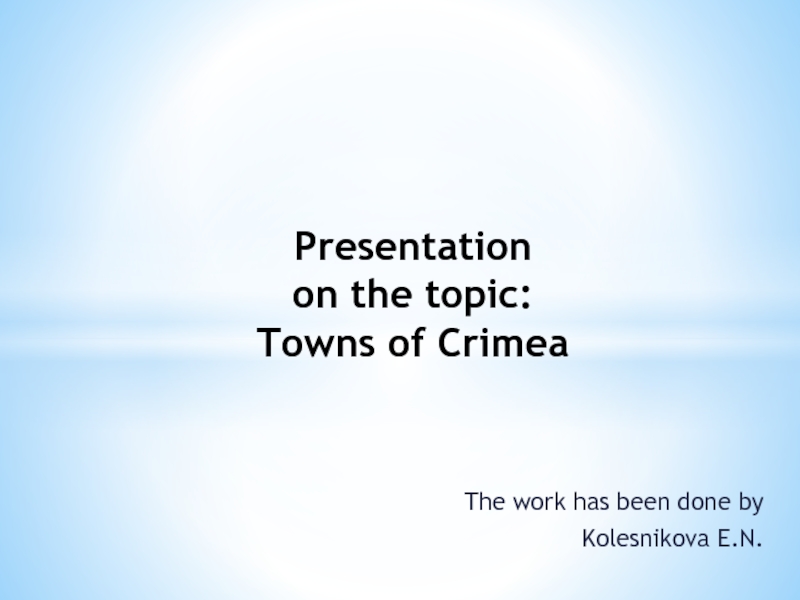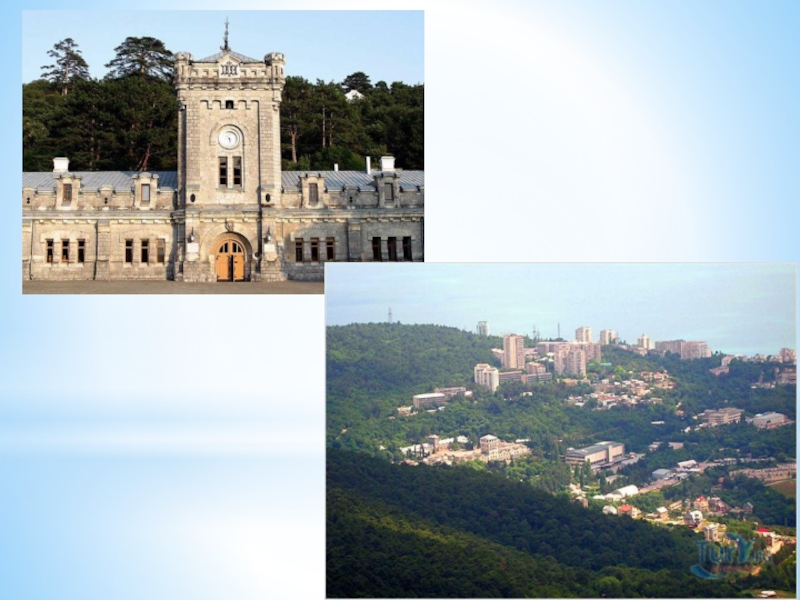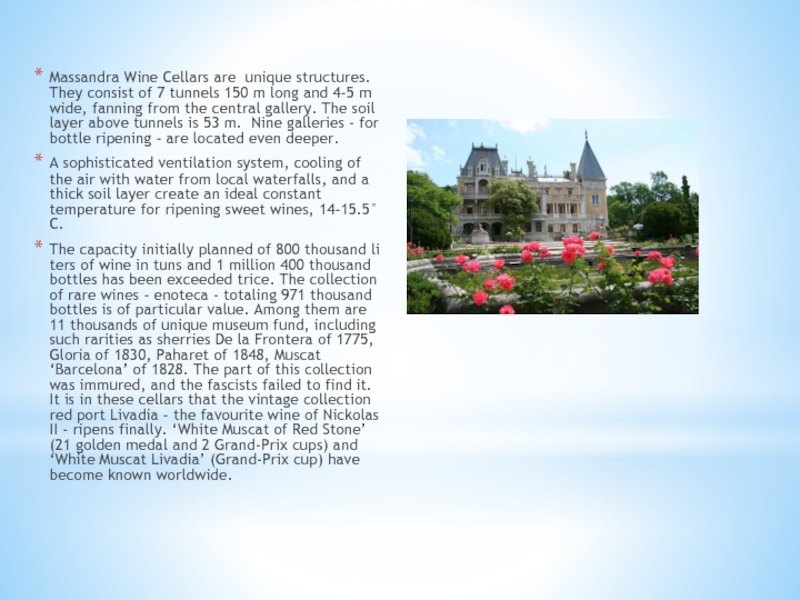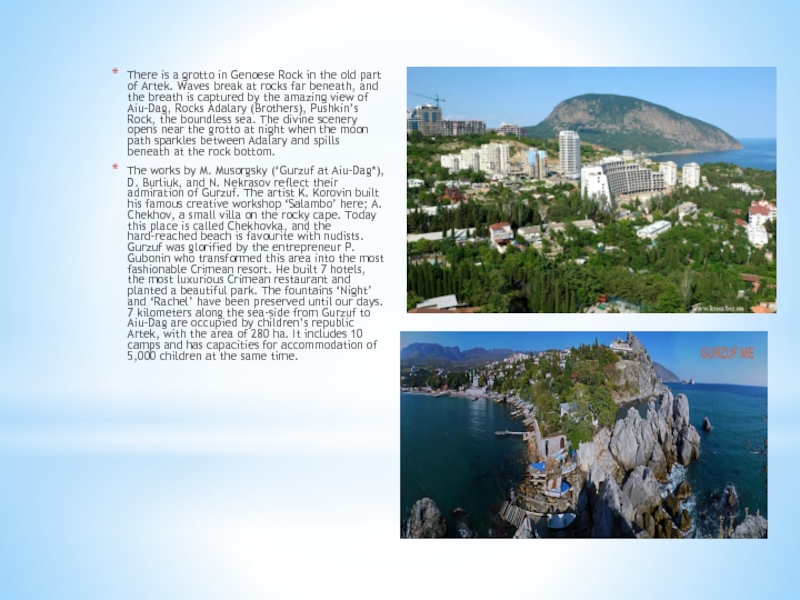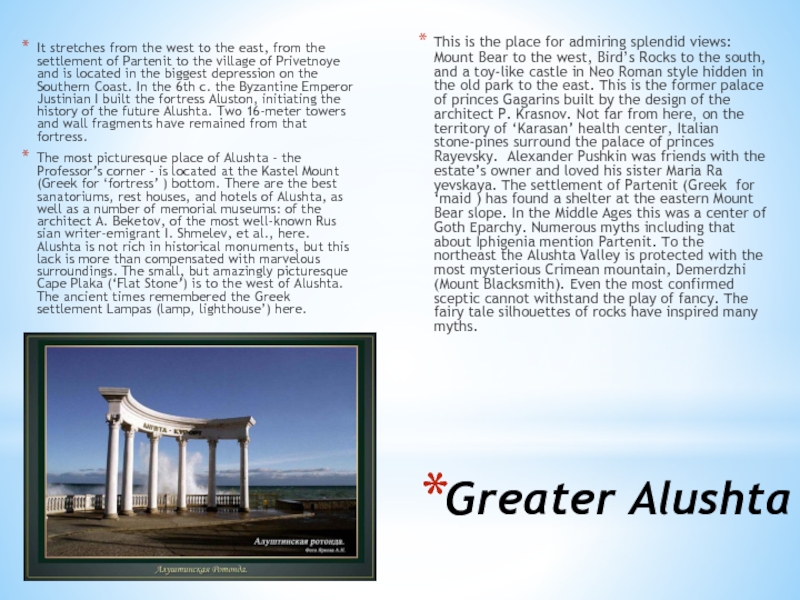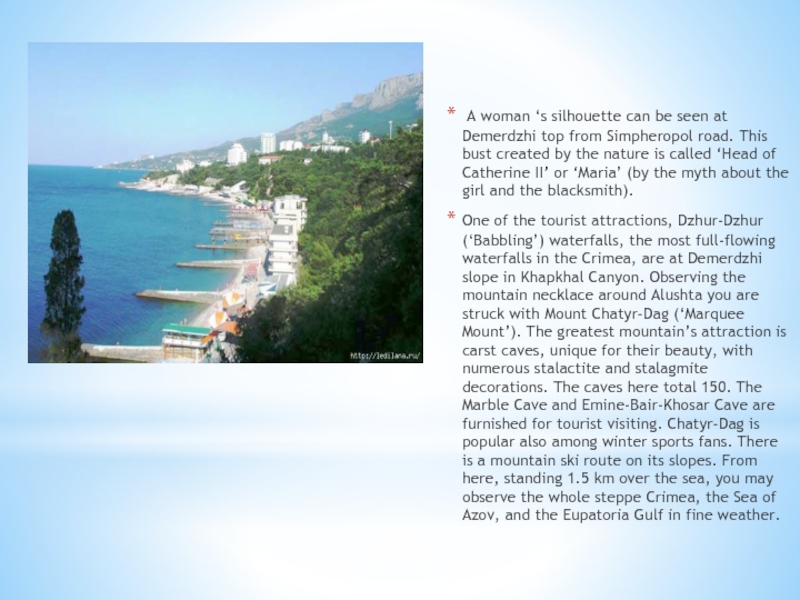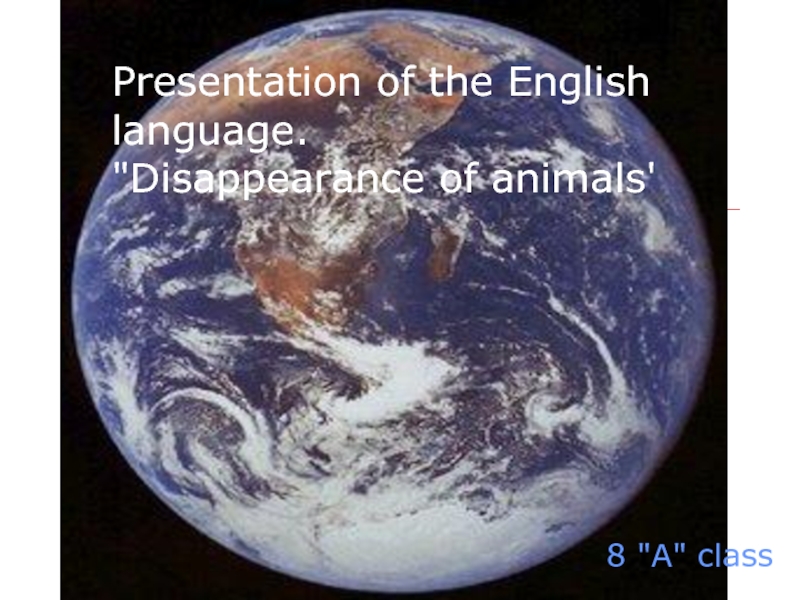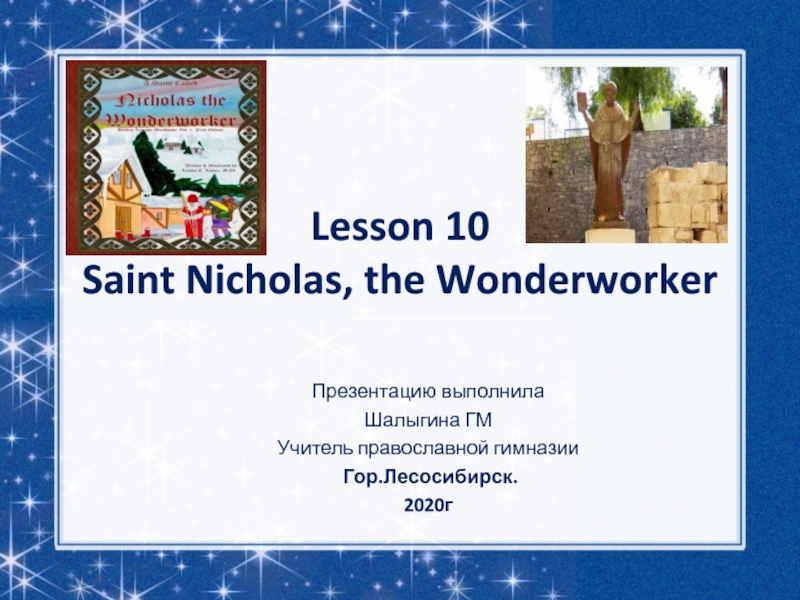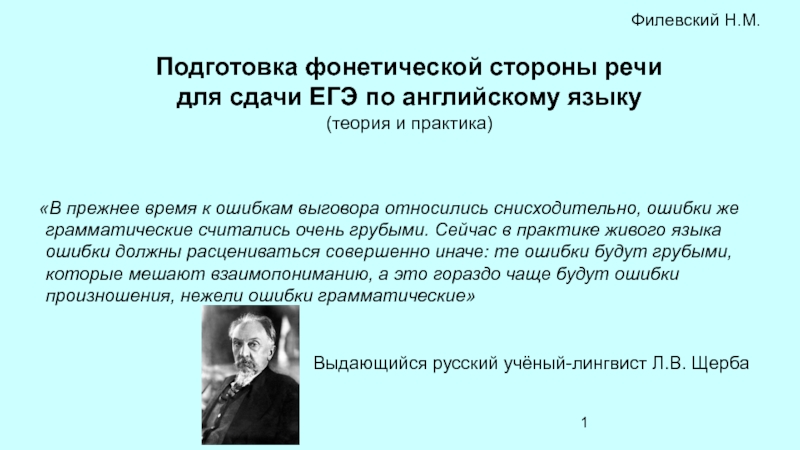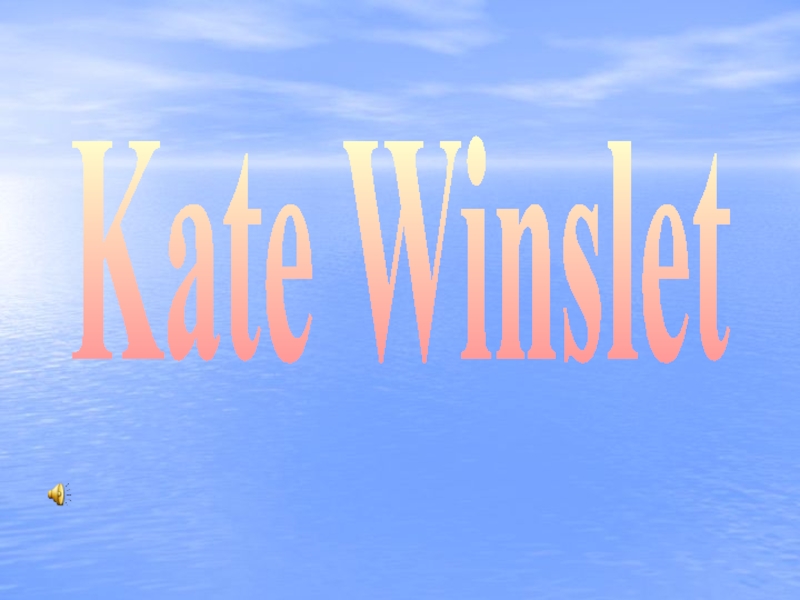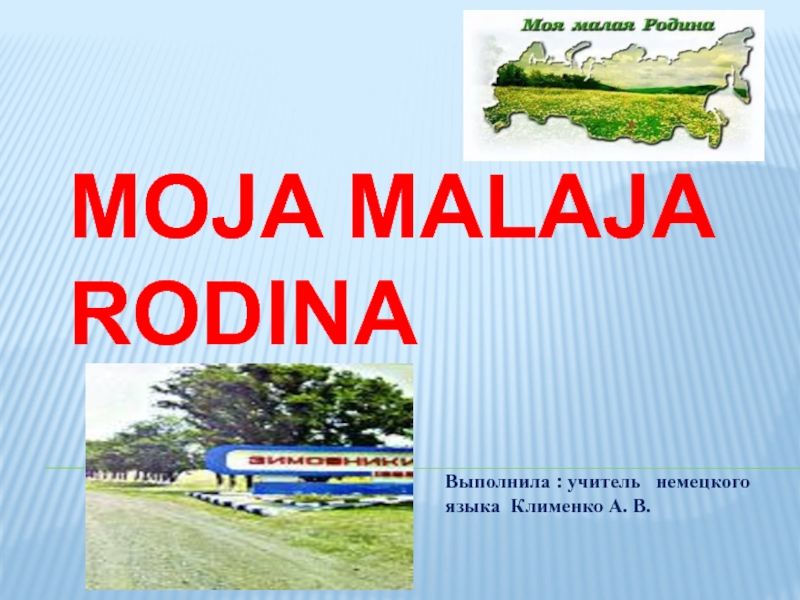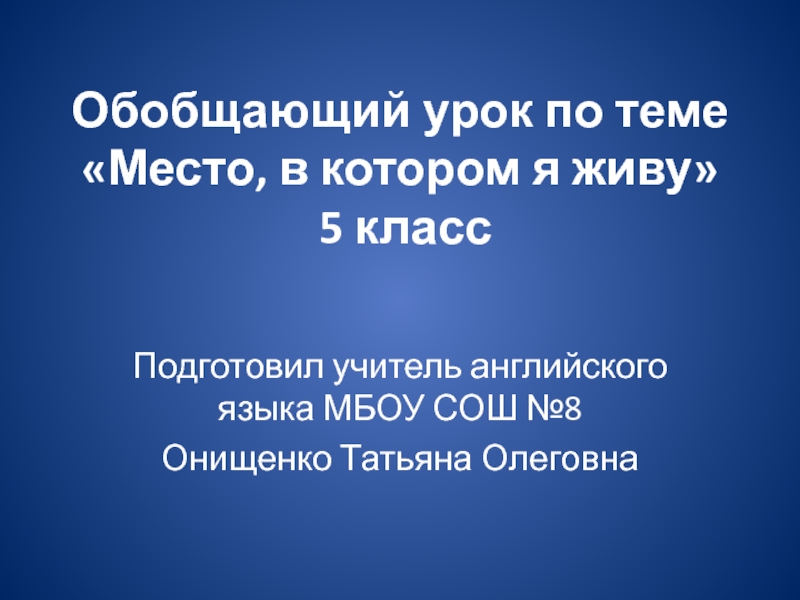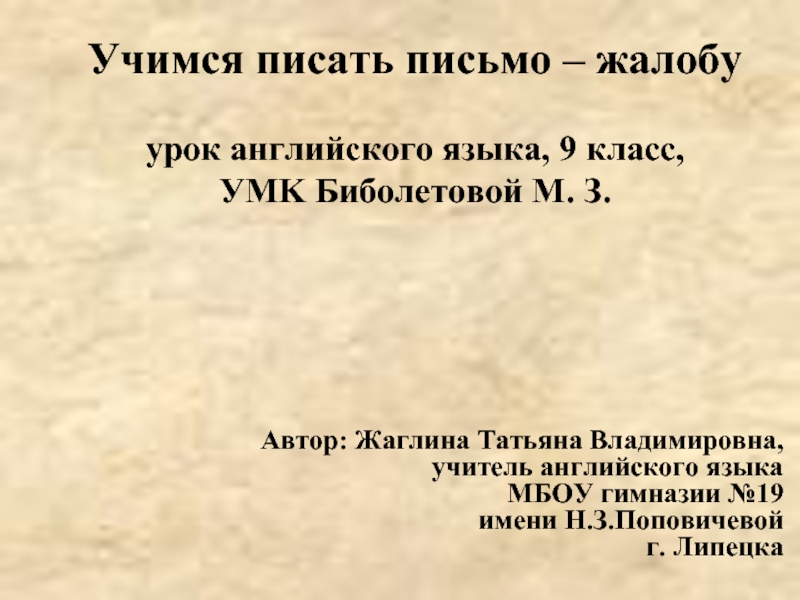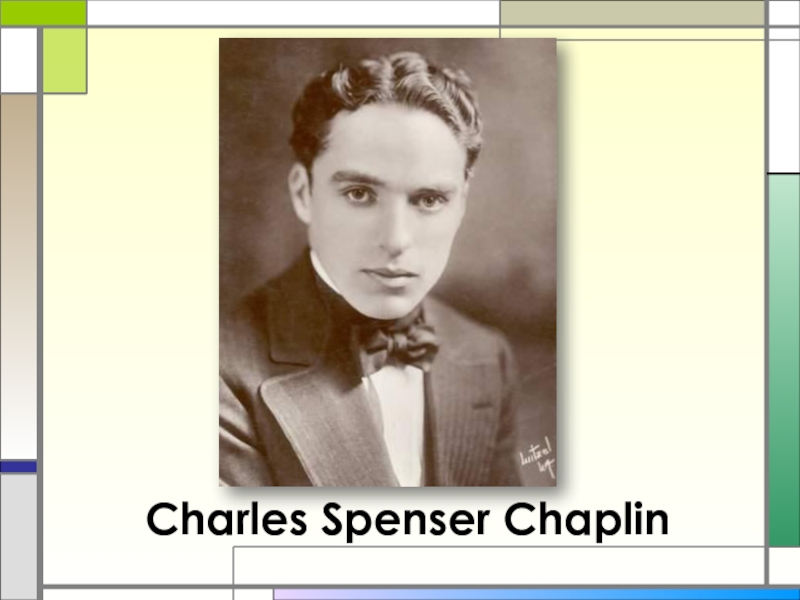Разделы презентаций
- Разное
- Английский язык
- Астрономия
- Алгебра
- Биология
- География
- Геометрия
- Детские презентации
- Информатика
- История
- Литература
- Математика
- Медицина
- Менеджмент
- Музыка
- МХК
- Немецкий язык
- ОБЖ
- Обществознание
- Окружающий мир
- Педагогика
- Русский язык
- Технология
- Физика
- Философия
- Химия
- Шаблоны, картинки для презентаций
- Экология
- Экономика
- Юриспруденция
Презентация для урока лингвострановедения "Города Крыма"
Содержание
- 1. Презентация для урока лингвострановедения "Города Крыма"
- 2. Massandra Massandra owes its glory to wine.
- 3. Слайд 3
- 4. Massandra Wine Cellars are unique structures. They
- 5. Gurzuf The first people appeared here 5
- 6. There is a grotto in Genoese Rock
- 7. Greater Alushta It stretches from the west
- 8. Remains of the fortress Funa (Greek
- 9. A woman ‘s silhouette can be
- 10. Скачать презентанцию
Слайды и текст этой презентации
Слайд 2Massandra
Massandra owes its glory to wine. Wine-making was initiated by
the Count Vorontsov but it became famous after the estate
had been bought by the Emperor Alexander III, He invited the Prince L. Golitsyn, whose work in Expert Committee at the World Wine Exhibition in Paris was awarded with a Legion of Honour by French government, to manage local wine growing and wine making. At the same time the emperor wanted to finish building the palace. The construction of the palace in a la Louis XIII style was started in 1881, but it was completed only in 1902, yet was never fully furnished. The emperor’s family used it only for rest during summer promenades and hunting. And the basic reason was that the main wine cellar had been created in Massandra. This impressive construction was finished in 1897.Слайд 4Massandra Wine Cellars are unique structures. They consist of 7
tunnels 150 m long and 4-5 m wide, fanning from
the central gallery. The soil layer above tunnels is 53 m. Nine galleries - for bottle ripening - are located even deeper.A sophisticated ventilation system, cooling of the air with water from local waterfalls, and a thick soil layer create an ideal constant temperature for ripening sweet wines, 14-15.5° C.
The capacity initially planned of 800 thousand liters of wine in tuns and 1 million 400 thousand bottles has been exceeded trice. The collection of rare wines - enoteca - totaling 971 thousand bottles is of particular value. Among them are 11 thousands of unique museum fund, including such rarities as sherries De la Frontera of 1775, Gloria of 1830, Paharet of 1848, Muscat ‘Barcelona’ of 1828. The part of this collection was immured, and the fascists failed to find it. It is in these cellars that the vintage collection red port Livadia - the favourite wine of Nickolas II - ripens finally. ‘White Muscat of Red Stone’ (21 golden medal and 2 Grand-Prix cups) and ‘White Muscat Livadia’ (Grand-Prix cup) have become known worldwide.
Слайд 5Gurzuf
The first people appeared here 5 thousand years ago. Later
the Tauri made a sanctuary on Dzenevez- Kala (Genoese Rock).
Under
the Emperor Justinian I In the 6th c. the construction of fortress Gurzuvita started at this rock. In the 13th-15th cc. the Genoese reconstructed and strengthened It. The main defensive block of fortification was located on the rock’s southern site. The northern site housed a water reservoir, and a small basilica was on the steep rock edge.In 1811 Duke de Richelieu well- known for Odessa inhabitants built his ‘hermitage’ (French for ‘country house’) in the Genoese Valley. In 1820 Alexander Pushkin spent ‘the happiest minutes of life’ in his house. Perhaps, It was the rest in Gurzuf that inspired him to write, ‘I am tempted and vivified by only thought that once I would have a plot of land in the Crimea.’ In Gurzuf he fell in love with Maria Rayevska. The Crimea’s charm was reflected in many his chef-d’oeuvres.
Слайд 6There is a grotto in Genoese Rock in the old
part of Artek. Waves break at rocks far beneath, and
the breath is captured by the amazing view of Aiu-Dag, Rocks Adalary (Brothers), Pushkin’s Rock, the boundless sea. The divine scenery opens near the grotto at night when the moon path sparkles between Adalary and spills beneath at the rock bottom.The works by M. Musorgsky (‘Gurzuf at Aiu-Dag*), D. Burliuk, and N. Nekrasov reflect their admiration of Gurzuf. The artist K. Korovin built his famous creative workshop ‘Salambo’ here; A. Chekhov, a small villa on the rocky cape. Today this place is called Chekhovka, and the hard-reached beach is favourite with nudists. Gurzuf was glorified by the entrepreneur P. Gubonin who transformed this area into the most fashionable Crimean resort. He built 7 hotels, the most luxurious Crimean restaurant and planted a beautiful park. The fountains ‘Night’ and ‘Rachel’ have been preserved until our days. 7 kilometers along the sea-side from Gurzuf to Aiu-Dag are occupied by children’s republic Artek, with the area of 280 ha. It includes 10 camps and has capacities for accommodation of 5,000 children at the same time.
Слайд 7Greater Alushta
It stretches from the west to the east, from
the settlement of Partenit to the village of Privetnoye and
is located in the biggest depression on the Southern Coast. In the 6th c. the Byzantine Emperor Justinian I built the fortress Aluston, initiating the history of the future Alushta. Two 16-meter towers and wall fragments have remained from that fortress.The most picturesque place of Alushta - the Professor’s corner - is located at the Kastel Mount (Greek for ‘fortress’ ) bottom. There are the best sanatoriums, rest houses, and hotels of Alushta, as well as a number of memorial museums: of the architect A. Beketov, of the most well-known Russian writer-emigrant I. Shmelev, et al., here. Alushta is not rich in historical monuments, but this lack is more than compensated with marvelous surroundings. The small, but amazingly picturesque Cape Plaka (‘Flat Stone’) is to the west of Alushta. The ancient times remembered the Greek settlement Lampas (lamp, lighthouse’) here.
This is the place for admiring splendid views: Mount Bear to the west, Bird’s Rocks to the south, and a toy-like castle in Neo Roman style hidden in the old park to the east. This is the former palace of princes Gagarins built by the design of the architect P. Krasnov. Not far from here, on the territory of ‘Karasan’ health center, Italian stone-pines surround the palace of princes Rayevsky. Alexander Pushkin was friends with the estate’s owner and loved his sister Maria Rayevskaya. The settlement of Partenit (Greek for ‘maid ) has found a shelter at the eastern Mount Bear slope. In the Middle Ages this was a center of Goth Eparchy. Numerous myths including that about Iphigenia mention Partenit. To the northeast the Alushta Valley is protected with the most mysterious Crimean mountain, Demerdzhi (Mount Blacksmith). Even the most confirmed sceptic cannot withstand the play of fancy. The fairy tale silhouettes of rocks have inspired many myths.
Слайд 8 Remains of the fortress Funa (Greek for ‘fumy’) and
a Greek church can be seen at the mountain bottom.
There was a trade way from Gurzuf to Alushta here in the middle ages, and the fortress played a key part in protecting eastern borders of the Feodoro Principality.The Valley of Ghosts is not far from the fortress. In the evening this valley studded with stone chaos animates. Legendary heroes, fortress towers, fantastic monsters are approaching from the haze. This astonishing performance cannot but capture your mind and emotions, and you will never forget it.
Слайд 9 A woman ‘s silhouette can be seen at Demerdzhi
top from Simpheropol road. This bust created by the nature
is called ‘Head of Catherine II’ or ‘Maria’ (by the myth about the girl and the blacksmith).One of the tourist attractions, Dzhur-Dzhur (‘Babbling’) waterfalls, the most full-flowing waterfalls in the Crimea, are at Demerdzhi slope in Khapkhal Canyon. Observing the mountain necklace around Alushta you are struck with Mount Chatyr-Dag (‘Marquee Mount’). The greatest mountain’s attraction is carst caves, unique for their beauty, with numerous stalactite and stalagmite decorations. The caves here total 150. The Marble Cave and Emine-Bair-Khosar Cave are furnished for tourist visiting. Chatyr-Dag is popular also among winter sports fans. There is a mountain ski route on its slopes. From here, standing 1.5 km over the sea, you may observe the whole steppe Crimea, the Sea of Azov, and the Eupatoria Gulf in fine weather.
